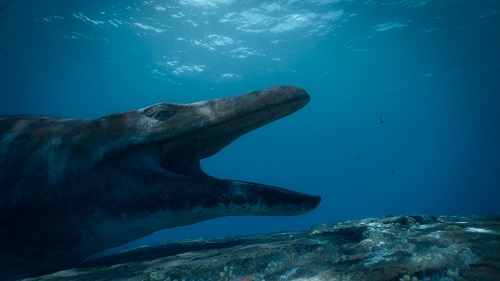For us, as for many science lovers, it’s currently our favorite season. Some might even call it the most wonderful time of the year: Shark Week.
The Discovery Channel’s annual full-channel takeover, devoted to all things predatory and sleek, is one of the single-most anticipated science events of the year. So we were a little disappointed — as, apparently, were many Discovery Channel viewers — when the network aired a film that implied that the extinct monstershark megalodon might not really be extinct.
We consider ourselves something of experts on the subject, because, well, this:

(That’s our Associate Curator of Paleontology, David Temple, with our Adult Education Director, Amy Potts, NOT being swallowed alive by an EXTINCT shark.)
We sat down with Associate Curator of Paleontology David Temple to dish over the epic bungle and set the record straight. Here’s his point-by-point breakdown of how wrong — WRONG WE TELL YOU! — it all is:
Point 1 (less a point than a fun fact):
The largest recorded (and verified) Great White Shark was caught off Prince Edward Island in 1988. It measured 20 feet long, meaning the 25-foot “Great White” featured in Jaws would have actually been more believable as a megalodon. The movie is, of course, fictional. Temple says there is a truism in diving that Discovery might have missed during its excitement over giant sharks: “Everything underwater looks a third bigger and a third closer than it really is, except for sharks. Then you can multiply that times 10.”
Point 2
For a threatened “living fossil” species to exist, they must retreat into the margins of their ecosystems. See: the Coelacanth. Megalodons required tropical, warm water to survive, and so for them, retreating into the depths of the ocean simply wouldn’t be a viable option.
Point 3
Megalodons were, as the Discovery Channel portrayed, extremely aggressive and proficient predators. As a result, their impact on their native ecosystems was great. If a population of megalodons yet existed, it’s impossible that we wouldn’t have noticed.
Point 4
If megalodons still existed, even in the cool depths where they couldn’t possibly survive, we would have seen a carcass by now. Even the Giant Squid, seen for the first time just last year, periodically washed up on shore to confirm its existence.
So in conclusion, while it’s fun to imagine a world in which megalodons still swam the seas (“Imagine Jaws on steroids,” says Temple); and while cryptozoologists chasing hidden and mythical creatures like the Loch Ness monster and Big Foot are occasionally right (see: the Okapi); you’d be far more likely to discover a small new species of frog than a 70-foot shark that could eat a fishing boat.
Point? Science.







